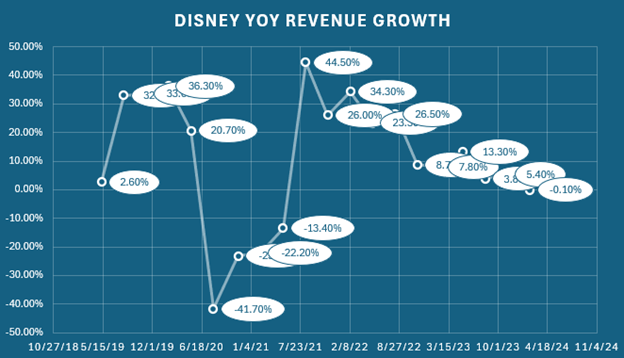Disney (DIS) is set to announce their quarterly results tomorrow morning before the market opens, and the stock couldn’t be positioned any worse for the news.
To say it’s been a tough few years for the company and its stock would be an understatement.
Disney stock spent all of 2022 and 2023 trading in a bear market, stripping more than 40% of the company’s market cap.
The rapid decline of Disney fell on a litany of reasons, including the year-long proxy battle with Nelson Peltz’s hedge fund, Trian partners. Other reasons included declining revenue, unimpressive streaming results, and the continuous question of how it would move forward with the ESPN brand.
Last month, Disney won the proxy battle when shareholders voted the company’s full slate of 12 directors to the board. That lifted some of the uncertainty over the company’s future, but the stock may be more susceptible to another move lower over the next three months if tomorrow’s results don’t knock investor’s socks off.
Here’s why…
Last quarter was a good one for the stock.
Shares rallied more than 30%, as investors started to get the hunch that Disney would win their battle with Peltz. At the same time, the company delivered a solid earnings report in February, catapulting the stock even higher. At the same time, Disney’s management gave an outlook that was better than investor’s expectations.
All of that is a sign of a “hope trade.”
Every investor out there loves catching a bottom. It’s why we take the risk of buying a stock like Disney when its down.
I always refer to Warren Buffett’s comments on buying stocks when there’s blood running through the street or when investors are most fearful. That wasn’t the case with Disney last quarter.
Many of the fundamental problems that existed – except for the proxy battle – are still in place. Those problems have led to a definite trend in the company’s year-over-year revenue growth as seen in the chart below.
Despite those fundamental issues, we’ve not seen a “blood in the streets” moment from investors. That’s the real risk for the stock as we head into tomorrow’s report.
The analyst community has remained steadfast in their support of the company.
Currently, the analyst recommendations on the stock are nearly as they were in 2022 and 2023. Investors and traders have remained equally bullish on the stock according to options activity as the tape heavily favors calls over puts.
This is what puts Disney in the earnings hotseat.
Despite the fundamental concerns for the stock, we’ve seen the investing community remain extremely bullish.
To give you a general comparison, Investors and analysts have become more pessimistic on their outlook on Apple (AAPL) and Tesla (TSLA) – two of the Magnificent Seven stocks – than they have on Disney. Neither have the flagging fundamentals of Disney.
To that point, any disappointment in the earnings report will send investors to reassess the stock, and Disney’s price charts are telling us that this is a “do or die” moment.
Currently, the stock’s price is sitting just above its 20- and 50-day moving averages. From a trading perspective, this is critical. A break below both trendline will cause an immediate increase in technical selling pressure. The next support, at $95 from the stock’s 200-day moving average.
That brings the next “fundamental” problem into play, which is a technical level as well.
Disney, like any other stock, sees increased buying or selling when it moves above or below the $100 price. The psychology of that “price point” weighed heavy on the market in November 2022 as it would if broken again.
A move back below $100 again with any uncertainty from the company’s outlook tomorrow would reset the selling cycle on the stock and increase the likelihood that Disney will fall prey to another long-term bear market trend.
To sum this picture up, Disney is a position in which the company needs to impress investors with their earnings and outlook. If not, the stock’s net stop is $100 and then $95 and then lower as investors finally begin to question the company’s value, pricing it accordingly.
About the Author
Chris Johnson (“CJ”), a seasoned equity and options analyst with nearly 30 years of experience, is celebrated for his quantitative expertise in quantifying investors’ sentiment to navigate Wall Street with a deeply rooted technical and contrarian trading style.





